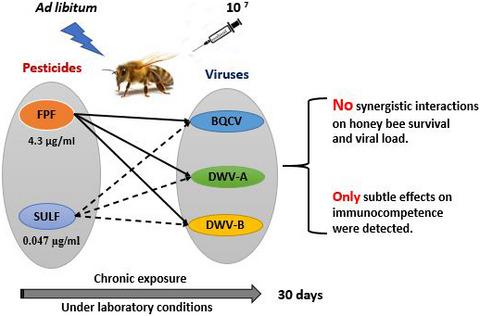当前位置:
X-MOL 学术
›
Microb. Biotechnol.
›
论文详情
Our official English website, www.x-mol.net, welcomes your
feedback! (Note: you will need to create a separate account there.)
The novel insecticides flupyradifurone and sulfoxaflor do not act synergistically with viral pathogens in reducing honey bee (Apis mellifera) survival but sulfoxaflor modulates host immunocompetence
Microbial Biotechnology ( IF 4.8 ) Pub Date : 2020-09-28 , DOI: 10.1111/1751-7915.13673 Yahya Al Naggar 1, 2 , Robert J Paxton 1
Microbial Biotechnology ( IF 4.8 ) Pub Date : 2020-09-28 , DOI: 10.1111/1751-7915.13673 Yahya Al Naggar 1, 2 , Robert J Paxton 1
Affiliation

|
The decline of insect pollinators threatens global food security. A major potential cause of decline is considered to be the interaction between environmental stressors, particularly between exposure to pesticides and pathogens. To explore pesticide–pathogen interactions in an important pollinator insect, the honey bee, we used two new nicotinic acetylcholine receptor agonist insecticides (nACHRs), flupyradifurone (FPF) and sulfoxaflor (SULF), at sublethal and field‐realistic doses in a fully crossed experimental design with three common viral honey bee pathogens, Black queen cell virus (BQCV) and Deformed wing virus (DWV) genotypes A and B. Through laboratory experiments in which treatments were administered singly or in combination to individual insects, we recorded harmful effects of FPF and pathogens on honey bee survival and immune gene expression. Though we found no evidence of synergistic interactions among stressors on either honey bee survival or viral load, the combined treatment SULF and DWV‐B led to a synergistic upregulation of dicer‐like gene expression. We conclude that common viral pathogens pose a major threat to honey bees, while co‐exposure to these novel nACHR insecticides does not significantly exacerbate viral impacts on host survival in the laboratory.
中文翻译:

新型杀虫剂氟吡呋酮和氟啶虫胺不会与病毒病原体产生协同作用,降低蜜蜂 (Apis mellifera) 的存活率,但氟啶虫胺能调节宿主免疫能力
昆虫传粉者的减少威胁着全球粮食安全。下降的一个主要潜在原因被认为是环境压力源之间的相互作用,特别是接触农药和病原体之间的相互作用。为了探索重要传粉昆虫——蜜蜂中农药与病原体的相互作用,我们使用了两种新型烟碱乙酰胆碱受体激动剂杀虫剂(nACHR),氟吡呋酮(FPF)和磺胺氟隆(SULF),在完全交叉的亚致死剂量和田间实际剂量下使用。实验设计了三种常见的病毒性蜜蜂病原体:黑蜂王细胞病毒(BQCV) 和变形翅病毒(DWV) 基因型 A 和 B。通过对个体昆虫单独或联合进行治疗的实验室实验,我们记录了FPF 和病原体对蜜蜂生存和免疫基因表达的影响。尽管我们没有发现压力源之间对蜜蜂生存或病毒载量存在协同相互作用的证据,但 SULF 和 DWV-B 联合治疗导致切丁机样基因表达的协同上调。我们的结论是,常见的病毒病原体对蜜蜂构成主要威胁,而同时接触这些新型 nACHR 杀虫剂并不会显着加剧实验室中病毒对宿主生存的影响。
更新日期:2020-09-28
中文翻译:

新型杀虫剂氟吡呋酮和氟啶虫胺不会与病毒病原体产生协同作用,降低蜜蜂 (Apis mellifera) 的存活率,但氟啶虫胺能调节宿主免疫能力
昆虫传粉者的减少威胁着全球粮食安全。下降的一个主要潜在原因被认为是环境压力源之间的相互作用,特别是接触农药和病原体之间的相互作用。为了探索重要传粉昆虫——蜜蜂中农药与病原体的相互作用,我们使用了两种新型烟碱乙酰胆碱受体激动剂杀虫剂(nACHR),氟吡呋酮(FPF)和磺胺氟隆(SULF),在完全交叉的亚致死剂量和田间实际剂量下使用。实验设计了三种常见的病毒性蜜蜂病原体:黑蜂王细胞病毒(BQCV) 和变形翅病毒(DWV) 基因型 A 和 B。通过对个体昆虫单独或联合进行治疗的实验室实验,我们记录了FPF 和病原体对蜜蜂生存和免疫基因表达的影响。尽管我们没有发现压力源之间对蜜蜂生存或病毒载量存在协同相互作用的证据,但 SULF 和 DWV-B 联合治疗导致切丁机样基因表达的协同上调。我们的结论是,常见的病毒病原体对蜜蜂构成主要威胁,而同时接触这些新型 nACHR 杀虫剂并不会显着加剧实验室中病毒对宿主生存的影响。










































 京公网安备 11010802027423号
京公网安备 11010802027423号